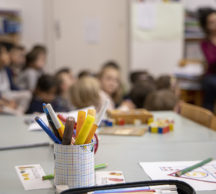Third-year primary class
The program in detail
- Reading
- Spoken language
- Writing
- Understanding
- Understanding literature
- Diction and memorising
- Spelling
- Grammar
- Vocabulary
- Handwriting
- Mathematics
- Numbers
- Space
- English
- Science
- Arts
- Rhythm
- Sports
Reading
- Revision of vowels and consonants studied on the second-year primary class
- Recognising and memorising the names of letters and words encountered in texts
- Identifying written words often featuring in pupils’ daily lives (first names of their friends, function words, etc.)
- Understanding the relation between phonemes and graphemes (methodical, gradual learning of sounds and their different written forms)
- Gradual reading of graphemes, syllables, words, sentences and texts (in cursive handwriting and printed writing)
- Silent reading guided by worksheets
Spoken language
- Developing phonological awareness
- Segmenting an utterance into words
- Segmenting a spoken word into syllables
- Segmenting spoken syllables into phonemes
Writing
- Writing through dictation with the teacher
- Writing a text for a recipient, in a group or individually
Understanding
Understanding and writing oral texts with informal and educational use
- Grasping the overall meaning and main ideas of a text
- Organising and reproducing words logically
- Adapting speech to a communication situation
- Considering characteristics of speech (pronunciation, volume, flow, motions, etc.) and the communicative context
Understanding literature
- Distinguishing publications by text type (Illustrated book, informative work, comic strip, etc.)
- Recognising a book’s particularities (title, author, illustrator, version, summary, etc.)
- Categorising works (by subject, author, version, collection, etc.)
- Identifying different written publications and their use (newspaper, telephone directory, catalogue, dictionary, etc.)
- Discovering emotions felt upon reading or listening to a book (fear, laughter, sadness, etc.)
- Identifying links with lived experience
Diction and memorising
- Memorising and reciting poems
Spelling
- Reproducing the twenty-six letters of the alphabet in the right order
- Locating letters of the alphabet in relation to each other
- Classing words by alphabetical order
- Looking up a word in a dictionary
- Faultless copying
- Recognising and using basic written forms in transcribing a sound
- Learning the spelling of a bank of frequently used words relating to class activities
- Dictation of letters, syllables, words, phrases and then texts
- Distinguishing proper nouns and nouns (upper case, lower case)
- Recognising the masculine and the feminine
- Recognising the singular and the plural
- Understanding agreement between the noun and the determiner in a simple noun group (plural with –s)
Grammar
- Identifying the components of a sentence
- Identifying the components of a noun group (determiner + noun)
- Identifying the verb in a simple sentence
- Proper noun, common noun (gender and number)
Vocabulary
- Developing and expanding a bank of words relating to class activities and reference works
- Using suitable vocabulary in the pupil’s own writing
- Classing words by criteria: hyponyms, words from the same family, words with similar meanings, words with opposite meanings
Handwriting
- Correct reproduction of numbers and lower-case letters
- Copying short texts in careful, readable, cursive handwriting
Mathematics
Pupils improve their mathematical knowledge in group lessons and workshops (games, building, handling, etc.) in which they take part alongside others or on their own to develop their independence.
Numbers
- Studying numbers up to 100
- Counting a collection of objects through organised counting in portions of ten
- Building a collection with a given number of objects
- Counting in tens up to 100, starting from a given number
- Going from a number as a spoken word to its written number form and vice versa
- Comparing, ordering, demarcating and inserting numbers below 100
- Resolving problems in addition and orally explaining the approach and result
- Learning and using basic mathematical symbols =, ≠
- Following careful procedures of calculation to effectively add together two numbers, the sum of which remains below 100 (without carrying)
Space
- Finding locations on a plane or in space (classing geometric shapes by various criteria, locating oneself and objects, identifying geometric shapes)
- Resolving problems in measuring sizes
English
- Knowledge already gained is consolidated and deepened through games, crosswords, picture-based stories, poems and songs, using the ‘Kid’s Box Starter’ (tbc) method
- Special programme for English-speaking pupils
Lessons are given in half-groups by a specialist teacher who is a native English-speaker.
Science
- Learning about natural science (physical and chemical phenomena, wildlife and plant biology) through observation and experiments
Arts
- Cultivating an appreciation of artistic activities, stimulating pupils’ creativity and imagination
- Trying out a wide range of techniques: drawing, painting, collage, cutting up, putting together, printing techniques, modelling, etc.
- Using a wide range of materials: paper, cardboard, soil, fabrics, plaster, natural material, etc.
- Introducing art: studying culture by associating names, works of artists, styles and readings
- Making objects and gifts for different events (Christmas, Mother’s Day, etc.)
Teachers use artistic activities to introduce pupils to specific vocabulary relating to their creations
Rhythm
Pupils feel what they hear through the bodily interpretation of sounds and rhythms played by the teacher.
Stimulating their motor skills helps them use their body as their first instrument.
- Singing songs accurately with musicality
- Recognising and reproducing binary and ternary rhythms
- Studying tempos with two, three and four beats
- Bodily development through music
- Creating several choreographic sequences
Weekly lessons given in half-groups by a teacher from Institut Jaques-Dalcroze.
Sports
- Discovering the body’s responses through different types of bodily movement (running, jumping, climbing, etc.)
- Learning to play in groups, in pairs, in threes, etc. (cooperative and collaborative games)
- Improving agility and coordination through various means (small and large balls, bench, pupil’s own body, etc.)
Toutes les informations pour procéder aux démarches d’admission sont disponibles en ligne :
Admissions






